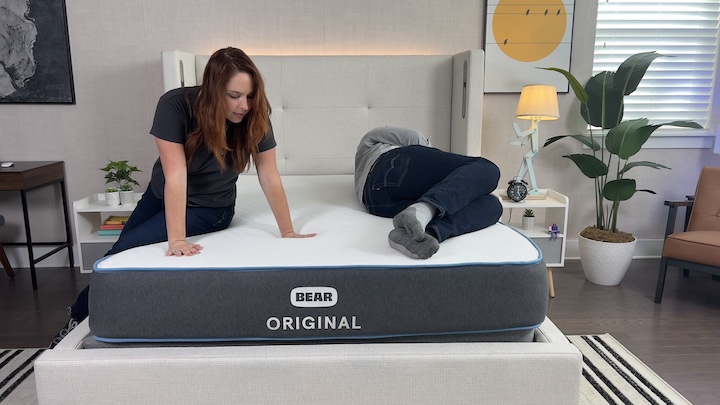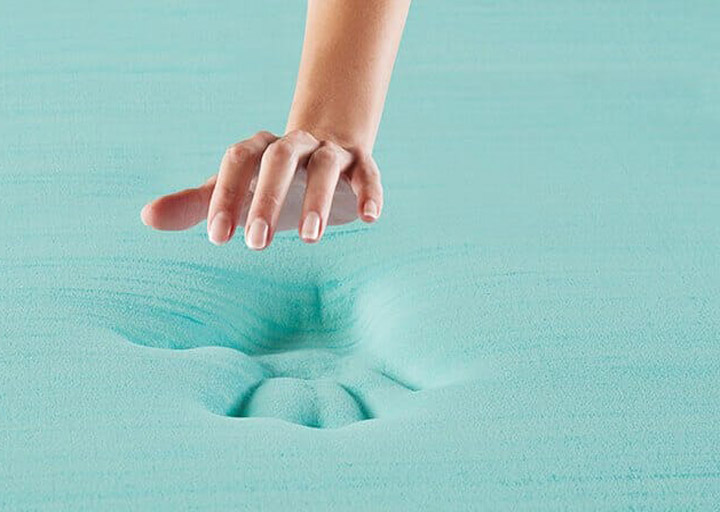Whether you share a bed with a partner or a pet, motion isolation is an important element to consider. If your mattress doesn’t isolate motion well, you might wake up when your loved one switches sleeping positions next to you.
When reviewing mattresses, we conduct hands-on motion isolation testing. Keep reading to learn more about our methodology.
Why Is Motion Isolation Important?
If you share a bed with a partner, you might feel their movements when they switch sleeping positions. In the mattress industry, we call this “motion transfer.” For some people, finding a mattress that isolates motion is particularly important.
Couples
Couples that share a bed will benefit the most from a motion-isolating mattress. This is especially true if partners have different sleep schedules and need to wake up at different times. Even if this isn’t the case, no one wants to be disturbed or wake up from feeling their partner toss and turn in their sleep. The best mattresses for couples tend to have excellent motion isolation and edge support.
People Who Sleep Next to Pets
Many pet owners enjoy the companionship of sharing their bed with their furry friend. Just like people, pets tend to move around or get in and out of bed throughout the night. When this happens, you don’t want to feel the shifting weight from your pet on your side of the bed. A mattress with exceptional motion isolation can prevent your pet’s movements from keeping you awake.
How We Test Motion Isolation
Here at Mattress Clarity, we thoroughly test each product we review. Here’s a closer look at how we measure motion transfer.
Glass of Water Test
First, we place a glass of water on top of the mattress and press into the cover around it. If we see the water ripple inside the glass, we know this mattress doesn’t isolate motion well. On the flip side, if the water remains still, we know the mattress does have good motion isolation.

Two Person Test
We get a lot of information from the glass of water, but the best way to understand how a mattress isolates motion is to test it ourselves. For this assessment, one person rests on the mattress while another person rolls around on the other side. If the person relaxing on the bed feels motion, they know the mattress doesn’t isolate motion well.

What Causes Motion Transfer in a Mattress?
A mattress’s ability to isolate motion mainly depends on its construction. Mattresses contain several layers of different materials, each with varying amounts of support.
A mattress’s base support layer typically dictates how well it isolates motion. Dense materials like memory foam absorb motion better than innerspring coils. The top comfort layer also plays a role in determining motion isolation. Thick, dense comfort layers absorb motion better than thin layers.
In addition to a mattress’ construction, the quality of materials, firmness level, and thickness all impact motion transfer. Thick mattresses with high-quality foam layers tend to isolate motion well.
How Materials Affect Motion Transfer
Quality materials and construction are everything when it comes to great motion isolation. Let’s go over the main types of mattresses and how each of them typically perform in motion isolation testing.
Memory Foam
Memory foam mattresses tend to isolate motion better than other types of beds. Dense foam layers absorb motion well, so you shouldn’t feel any movement from another person sharing your bed. The higher the density of the foam in the comfort layer, the better it should isolate motion.

Standard memory foam often has a slow-moving feel that conforms to your body and offers excellent pressure relief. But it’s important to note that memory foam mattresses can be difficult to move around on top of. A mattress with a “quicksand” feel (think TEMPUR-Pedic) can be highly beneficial if you have back or joint pain, but it can sometimes make you feel like you’re “stuck inside” the mattress.
Latex Hybrid
Some latex mattresses isolate motion well, but overall, they don’t perform as well as memory foam mattresses. Generally, latex has a bouncy and buoyant feel. So when someone moves around on one side of a latex mattress, the motion tends to transfer across the whole bed.
There are three types of latex commonly found in latex mattresses. Talalay latex and Dunlop latex are both natural materials, but Dunlop latex is more dense and therefore better at reducing motion transfer. Some mattress brands use synthetic latex in their comfort layers, which is more affordable, but doesn’t always isolate motion well.

Latex mattresses are much easier to move around on than slow-moving all-foam mattresses. Latex is also a naturally cooling and long-lasting material, which is why latex mattresses tend to cost more than others on the market.
Memory Foam Hybrid
Memory foam hybrid mattresses have a slightly different feel than latex hybrid mattresses. Hybrid mattresses with memory foam comfort layers combine the comfort and pressure relief of soft foam with the support of durable coils. A mattress’s comfort layer needs to be at least 2” thick to be considered a hybrid mattress.
Since hybrid mattresses contain many materials, their motion isolation performance is mixed. If a hybrid mattress has a thick layer of high-density foam, you can expect it to isolate motion moderately well. Other hybrid mattresses may not absorb motion as well, even if they are made with memory foam.
Additionally, not all memory foam comfort layers have a traditional slow-moving feel. Some hybrid beds have a balanced foam feel, which won’t make you feel like you are “stuck inside” your bed.
RELATED: Memory Foam vs Latex Mattresses
Innerspring
Usually, traditional innerspring mattresses don’t perform well in motion isolation tests. Innerspring mattresses are very bouncy and respond immediately to shifting weight or tossing and turning.
Pocketed coils (those that are individually wrapped) tend to isolate motion better than free-standing coils. Individually-wrapped coils move independently and reduce motion transfer across the support layer.

Innerspring beds have thin comfort layers, so when you rest on top of one, you’ll feel more of the coils underneath. Thin comfort layers can’t absorb as much motion as thick layers made with memory foam or latex.
Although innerspring mattresses are not ideal if you need motion isolation, they may be a good option if you sleep hot at night or need more lumbar support.

RELATED: Should Your Dog Sleep In Bed With You?
Light Sleepers
If you sleep alone, motion transfer is typically less of a concern. This might not be the case if you are a light sleeper and need to sleep in complete silence. If the slightest noise or movement could wake you up, a low motion transfer mattress may help prevent some of these disturbances.
FAQs
What is motion transfer?
Motion transfer refers to the amount of movement that disperses from one side of a mattress to the other. This movement is usually caused by another person shifting sleeping positions or getting in and out of bed at night. Mattresses with excellent motion isolation will limit the amount of motion transfer you feel when sharing a bed.
Will a topper help with motion transfer?
The right mattress topper can help isolate motion if your mattress is extra bouncy and responsive. Look for a mattress topper made from high-density memory foam to help reduce motion transfer.
Which mattresses have the best motion isolation?
All-foam mattresses absorb and isolate motion better than many other types of mattresses. The higher the density of the foam in a mattress’ comfort layer, the better it should limit motion transfer. Some latex mattresses also isolate motion well, but they are more responsive than memory foam mattresses.